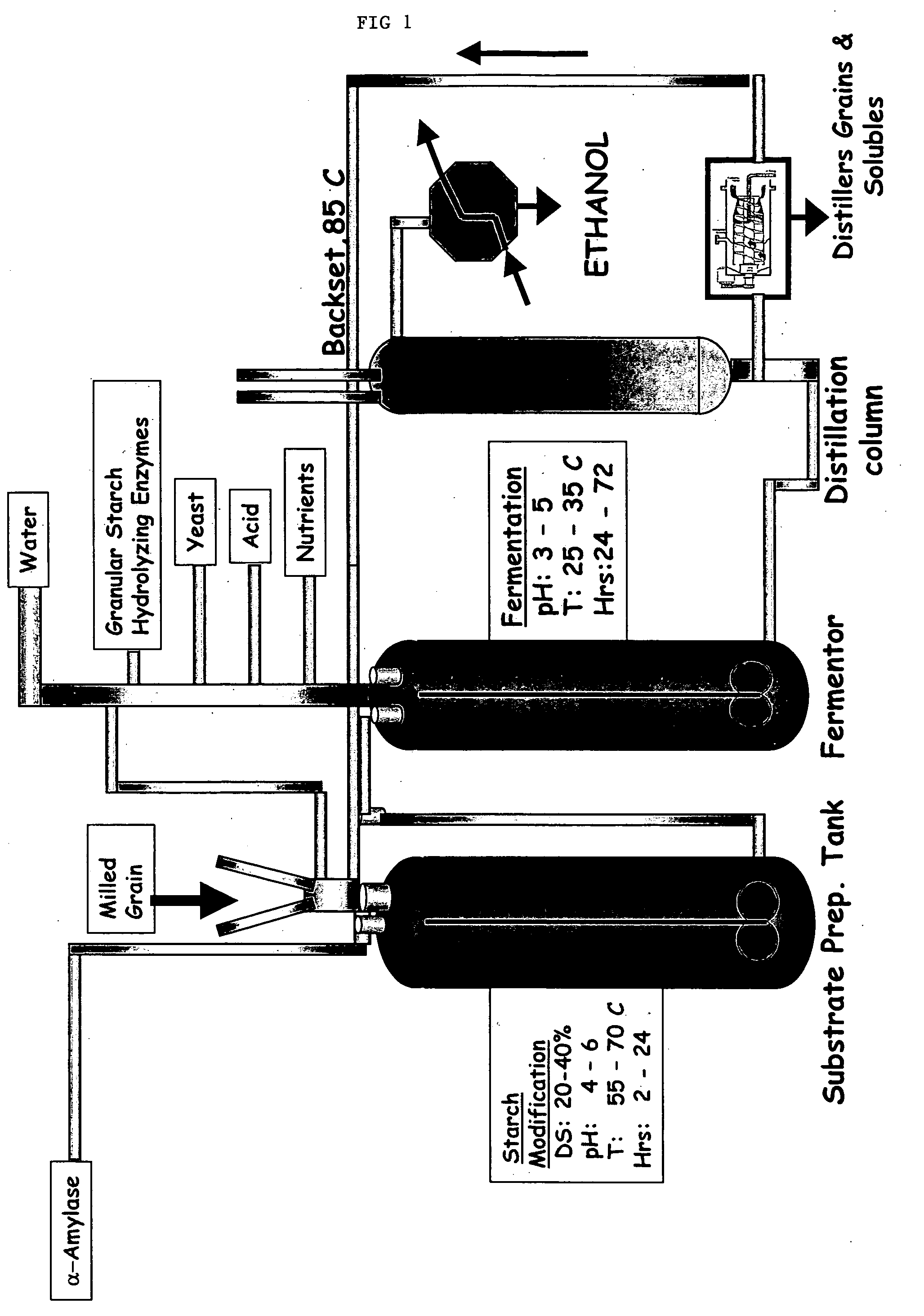Process for conversion of granular starch to ethanol
a technology of ethanol and starch, applied in the field of alcohol production processes, can solve problems such as reducing the growth rate of bacteria
- Summary
- Abstract
- Description
- Claims
- Application Information
AI Technical Summary
Benefits of technology
Problems solved by technology
Method used
Image
Examples
example 1
Solubilization and Ethanol Production From Granular Starch of Whole Ground Corn and Fractionated Corn
[0134]This experiment was run on three different corn granular starch substrates (A) 370 g of whole ground corn having a moisture content of 13.3%; (B) 354.2 g corn endosperm having a moisture content of 9.2%; and (C) refined corn starch obtained from having a moisture content of 11.8%. Each substrate was weighed and transferred to a stainless steel vessel to make a final 1000 g slurry with water corresponding to 32% DS.
[0135]The pH of the slurry was adjusted to pH 5.5 using 6N H2SO4. GC100 (4.0AAU / g DS) was added. The temperature was maintained at 60° C. During the incubation the slurry was gently stirred with an overhead mixer. After time internals of 2, 4, 6, 12 and 24 hours, the BRIX, % solublilzed starch and sugar compositions (% W / W) were determined, and the results are illustrated in Table 1. At 24 hours, 79.1%, 71.1% and 60.0% of the granular starch from whole ground corn, en...
example 2
Solubilization and Ethanol Production From Milo Granular Starch
[0137]Two pretreatments were run: (A) 160 g of whole ground milo having a moisture content of 11.6% and a total starch content of 53.3% was weighed and transferred to a stainless steel vessel containing 340 g water. The pH of the slurry was adjusted to pH 5.5 using 6 N sulphuric acid. SPEZYME Ethyl (1.0 AAU / g DS) was added. The temperature was maintained at 62° C. and 32% DS. (B) HGA was included in the pretreatment as described above in (A) at the equivalent of 0.1 GAU HGA / g DS. The % solublized solids and % glucose are presented in Table 3.
TABLE 3%Time% DP1%%solublizedEnzyme(hrs)(glucose)DP2DP3% DP > 3starchSPEZYME257.7124.6010.427.27Ethyl464.4122.509.133.95667.1621.838.162.852486.509.912.950.6354.7SPEZYME284.349.481.474.72Ethyl + HGA487.728.071.183.03688.917.681.032.372493.105.260.591.0569.3
[0138]The feedstock (mash) from the HGA pretreatment described above was evaluated under regular yeast fermentation conditions (e...
example 3
Effect of Temperature on Glucose Production From Whole Ground Milo
[0139]Incubation of a 30% ds aqueous slurry of whole ground milo at pH 5.5 containing GC100 (4.0 AAU / g DS) was carried out at 60° C., 65° C. and 70° C. After 6 hours of the incubation, the samples were withdrawn and centrifuged to separate the insolubles. The Brix and HPLC composition of the clear supernatant was measured. The % solubilized starch and % glucose were determined and the results are illustrated in Table 5.
TABLE 5%% W / WSolubilizedDP1% W / W% W / W% W / W° C.Starch(Glucose)DP2DP3DP > 36069.952.4827.0712.088.366568.252.6123.4210.4113.567061.936.4918.9810.2734.26
[0140]As the incubation temperature increased from 60° C. to 70° C. during the contacting step with whole ground milo, the solubilization of starch and the glucose content decreased. This suggests that the alpha-amylase may be inactivated at 70° C. More than 50% of the solubilized starch was hydrolyzed to glucose at 65° C. suggesting the endogenous plant s...
PUM
 Login to View More
Login to View More Abstract
Description
Claims
Application Information
 Login to View More
Login to View More - R&D
- Intellectual Property
- Life Sciences
- Materials
- Tech Scout
- Unparalleled Data Quality
- Higher Quality Content
- 60% Fewer Hallucinations
Browse by: Latest US Patents, China's latest patents, Technical Efficacy Thesaurus, Application Domain, Technology Topic, Popular Technical Reports.
© 2025 PatSnap. All rights reserved.Legal|Privacy policy|Modern Slavery Act Transparency Statement|Sitemap|About US| Contact US: help@patsnap.com

